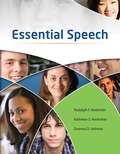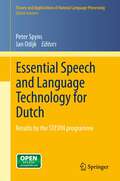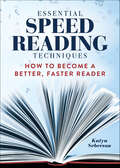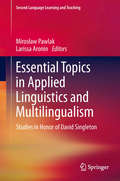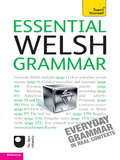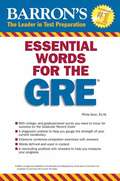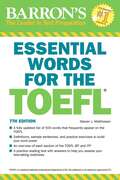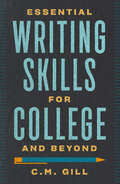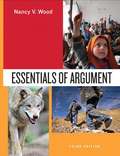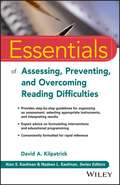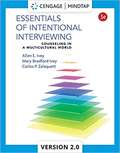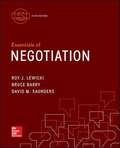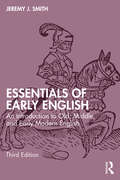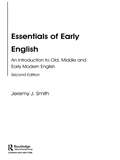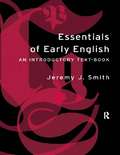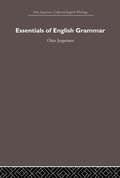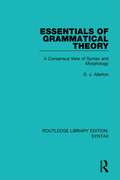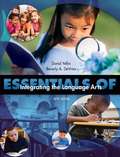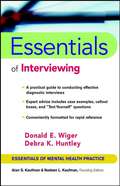- Table View
- List View
Essential Speech
by Rudolph F. Verderber Kathleen S. Verderber Deanna D. SellnowLearn the basics of communication to mastering speech preparation and delivery with this engaging, dynamic text. ESSENTIAL SPEECH introduces the various types of speeches as well as the keys for effective speech preparation and confident delivery. Relevant activities and examples of effective and ineffective communication make learning easier. Strong speeches begin with thorough preparation. Users develop into confident, competent communicators as they learn to research and use language and vocabulary effectively. Useful delivery strategies as well as how to perfect listening, observing, analyzing, and critiquing abilities are also addressed. This book's inviting and open visual presentation, along with numerous examples drawn from today's world, keep the presentation meaningful and engaging. Numerous hands-on activities also keep users actively involved in learning. Ongoing review and assessment ensure understanding of the concepts before moving ahead. Technology has had a huge influence on how you learn, how you work, and how you communicate today. The online Speech Builder Express tool solves the major challenges in this course: getting organized and comfortable to make a presentation, and relieving anxiety and stress caused by lack of planning and organization. Speech Builder Express coaches users through every step of the speech outlining process. By providing the necessary tutorials, sample videos, and access to a dictionary and thesaurus, this product will help build confidence, lessen anxiety, and prepare users for real-world career speaking opportunities. Discover all of the aspects of teaching speech - from concepts and practice to technology support. This book's approach is based on extensive field research and input from Speech Educators across the nation.
Essential Speech and Language Technology for Dutch: Results by the STEVIN-programme (Theory and Applications of Natural Language Processing #14)
by Peter Spyns Linde Van Bosch Jan OdijkThe book provides an overview of more than a decade of joint R&D efforts in the Low Countries on HLT for Dutch. It not only presents the state of the art of HLT for Dutch in the areas covered, but, even more importantly, a description of the resources (data and tools) for Dutch that have been created are now available for both academia and industry worldwide. The contributions cover many areas of human language technology (for Dutch): corpus collection (including IPR issues) and building (in particular one corpus aiming at a collection of 500M word tokens), lexicology, anaphora resolution, a semantic network, parsing technology, speech recognition, machine translation, text (summaries) generation, web mining, information extraction, and text to speech to name the most important ones. The book also shows how a medium-sized language community (spanning two territories) can create a digital language infrastructure (resources, tools, etc.) as a basis for subsequent R&D. At the same time, it bundles contributions of almost all the HLT research groups in Flanders and the Netherlands, hence offers a view of their recent research activities. Targeted readers are mainly researchers in human language technology, in particular those focusing on Dutch. It concerns researchers active in larger networks such as the CLARIN, META-NET, FLaReNet and participating in conferences such as ACL, EACL, NAACL, COLING, RANLP, CICling, LREC, CLIN and DIR ( both in the Low Countries), InterSpeech, ASRU, ICASSP, ISCA, EUSIPCO, CLEF, TREC, etc. In addition, some chapters are interesting for human language technology policy makers and even for science policy makers in general.
Essential Speed Reading Techniques: How to Become a Better, Faster Reader
by Katya SebersonFly through books with this essential speed reading guide.Faster reading is possible without sacrificing understanding—and this handbook will get you up to speed. Learn the most effective speed reading techniques for your personal strengths and challenges, and make visible progress through a series of engaging exercises.Choose from a variety of strategies and practices proven to advance speed and improve reading comprehension. The integrated exercises help develop your skills, allowing you to read quickly—and still enjoy every word. Whether you're reading an entertaining novel or a challenging textbook, this speed reading guide will help you sail right through.In Essential Speed Reading Techniques, you'll find:Achievable goals—Improve your speed by setting realistic goals based on your own individual baseline.Track your improvement—Assess your progress with self-tests for knowledge retention, smooth eye movement, and more.Tips and tricks—Discover speed reading strategies to minimize rereading, focus your attention, and reduce eyestrain from screens.With the personalized strategies in Essential Speed Reading Techniques, boosting your speed and reading comprehension will be a breeze.
Essential Topics in Applied Linguistics and Multilingualism
by Mirosław Pawlak Larissa AroninThis book brings together papers dealing with essential issues in applied linguistics and multilingualism that have been contributed by leading figures in these two fields and present state-of-the-art developments in theory and research. The first part includes articles touching on various aspects of multiple-language acquisition, with a particular emphasis on the role of affordances, the interfaces between language and thought, and factors influencing the process of language learning. Part Two deals with individual variations in the acquisition of additional languages, focusing in particular on the impact of such variables as age, aptitude, motivation and learning deficits. Finally, Part Three presents contributions illuminating key issues in the acquisition of different subsystems and skills, such as grammar, phonology, lexis and writing systems. Thanks to the diversity of perspectives on applied linguistics and multilingualism, as well as the cutting-edge nature of some of the proposals, this edited collection will be an important reference work and a source of inspiration for theorists and researchers.
Essential Welsh Grammar: Teach Yourself
by Christine JonesEssential Welsh Grammar will help you get more out of your study of Welsh. Essential Welsh Grammar is an up-to-date introduction to Welsh grammar. You don't need to know a lot about grammar before you start. Everything is explained simply and there are lots of examples to illustrate each point. Unlike more traditional grammars, Essential Welsh Grammar is structured so that you can look up language forms according to what you want to say, even if you don't know the grammatical term for them. If you already know some grammar, then you can use the 'reference grammar' section at the back of the book to look up the points you need.The course consists of 27 units illustrating the various uses to which the language can be put, for example, giving instructions or talking about the recent past. The more traditional reference grammar deals with grammatical structures, such as the imperative or the perfect tense. All grammatical terms are explained in the glossary at the back of the book. Each unit contains exercises for you to practise what you have learnt and there is a key at the back of the book for you to check your answers. The new page design in this edition means that the book is even easier to use and the main headings are in English so that you can find your way around the book quickly. This edition contains a 'taking it further' section which will direct you to further sources of real Welsh. Essential Welsh Grammar will help you to understand and manipulate Welsh grammar with confidence because:- you need no prior knowledge of grammatical terminology to use it;- the approach is accessible and supportive;- the examples are clear and in context;- exercises help you practise every point.
Essential Words for the GRE (Third Edition)
by Philip GeerAn extensive working vocabulary is a prerequisite for success on the Graduate Record Exam. This popular manual presents 800 college-graduate-level words with definitions that frequently appear on the exam. The book begins with a pre-test to help readers assess strenghts and weaknesses. Additional features include: An overview of the Verbal Reasoning question types found on the GRE Matching and sentence completion exercises for all word lists An analysis of essential word roots Suggested study plans, and much more. . . The book concludes with a post-test to assess progress. Answers are provided for all exercises and for all questions in the pre- and post-test.
Essential Words for the Toefl, 7th edition (Barron's Essential Words Ser.)
by Steven J. MatthiesenThis revised book is specifically designed for ESL students preparing to take the TOEFL and features updated vocabulary that is seen most often on the exam. It includes:Phrases and “purpose” words (for example, define, discuss, claim, etc.) that are used in the speaking and writing sections of the test New words and phrases, since you are often asked to explain the meaning of a phraseLists of vocabulary words with definitions, sample sentences, and practice exercises for 500 need-to-know wordsDetailed advice to help students expand their English language vocabulary, and moreStudents can test their mastery of TOEFL vocabulary by taking the included practice test with answer key, which is designed to help students evaluate their progress, and increase confidence in their vocabulary skills.
Essential Writing Skills for College and Beyond
by Charlene GillHone Your Writing Skills for Success in College and in Life! Every student knows that writing a successful college paper is no small undertaking. To make the grade, you need to express your ideas clearly and concisely. So how do you do it? In Essential Writing Skills for College and Beyond, you'll learn down-to-earth strategies for organizing your thoughts, researching the right sources, getting it down on paper...and earning an A. Write any type of college paper: Techniques for writing term papers, essays, creative assignments, and more. Improve your writing: Brainstorm ideas, research like a pro, draft and structure your paper, and polish your writing. Master the nuts and bolts: Avoid common mistakes in grammar, spelling, and punctuation. Turn it in on time: Stay organized with timelines tailored for a variety of papers. Take it to the next level: Get advice for writing effectively after graduation and on the job. College writing may seem daunting, but it doesn't have to be. No matter what your major or field of study, Essential Writing Skills for College and Beyond will help you take charge of your writing, your grades, and your path to success.
Essentials Of Argument
by Nancy V. WoodThis concise argument text presents a broad range of rhetorical theory while providing the clear explanations and examples to make it accessible to an exceptionally wide range of students. Essentials of Argument, 3e, contains ten chapters, each accompanied by class exercises and writing assignments. Students using this text will learn to identify topics of personal and social consequence, to read and form opinions of their own, to analyze a potential audience, and to write persuasive argument papers. Research methods are introduced early, instructing students how to locate, print, and evaluate online materials and avoid plagiarism.
Essentials Of Assessing, Preventing, And Overcoming Reading Difficulties (Essentials Of Psychological Assessment Ser.)
by David KilpatrickPractical, effective, evidence-based reading interventions that change students' lives Essentials of Understanding and Assessing Reading Difficulties is a practical, accessible, in-depth guide to reading assessment and intervention. It provides a detailed discussion of the nature and causes of reading difficulties, which will help develop the knowledge and confidence needed to accurately assess why a student is struggling. Readers will learn a framework for organizing testing results from current assessment batteries such as the WJ-IV, KTEA-3, and CTOPP-2. Case studies illustrate each of the concepts covered. A thorough discussion is provided on the assessment of phonics skills, phonological awareness, word recognition, reading fluency, and reading comprehension. Formatted for easy reading as well as quick reference, the text includes bullet points, icons, callout boxes, and other design elements to call attention to important information. <p><p> Although a substantial amount of research has shown that most reading difficulties can be prevented or corrected, standard reading remediation efforts have proven largely ineffective. School psychologists are routinely called upon to evaluate students with reading difficulties and to make recommendations to address such difficulties. This book provides an overview of the best assessment and intervention techniques, backed by the most current research findings. <p> Bridge the gap between research and practice Accurately assess the reason(s) why a student struggles in reading Improve reading skills using the most highly effective evidence-based techniques Reading may well be the most important thing students are taught during their school careers. It is a skill they will use every day of their lives; one that will dictate, in part, later life success. Struggling students need help now, and Essentials of Understanding and Assessing Reading Difficulties shows how to get these students on track.
Essentials Of Intentional Interviewing : Counseling In A Multicultural World
by Allen E. Ivey Mary Bradford Ivey Carlos P. ZalaquettAn excellent guide to interviewing in the helping professions, ESSENTIALS OF INTENTIONAL INTERVIEWING, 3rd Edition, presents the authors' renowned microskills model, which revolutionized modern understanding of the counseling and therapy process by teaching vital interviewing skills step-by-step. This demystifying process breaks down counseling into manageable micro units and builds a bridge between theoretical understanding, mastery of the skills, and the practice of counseling. The book's multicultural focus reflects the diverse nature of today's classroom-and society. New to this edition are a chapter on crisis counseling, basic information on neuroscience as it relates to interviewing, new video content, and brief summaries of key theories of helping (with additional information and transcripts available online). In addition, MindTap-an online learning platform with a full array of text-specific study tools-is available with the new edition.
Essentials Of Negotiation
by David M. Saunders Roy J. Lewicki Bruce BarryEssentials of Negotiation, 6e is a condensed version of the main text, Negotiation, Seventh Edition. It explores the major concepts and theories of the psychology of bargaining and negotiation, and the dynamics of interpersonal and inter-group conflict and its resolution. Twelve of the 20 chapters from the main text have been included in this edition, several chapters having been condensed for this volume. Those condensed chapters have shifted from a more research-oriented focus to a more fundamental focus on issues such as critical negotiation subprocesses, multiparty negotiations, and the influence of international and cross-cultural differences on the negotiation process.
Essentials of Children's Literature (Seventh Edition)
by Carol Lynch-Brown Carl M. Tomlinson Kathy G. Short'Essentials of Children's Literature' is a brief, affordable, comprehensive textbook with rich resources-- a true compendium of information about children's literature. It is tailored to a survey course in children's literature but, by virtue of its brevity and affordability, is also suitable as a companion text in an integrated language arts course.
Essentials of Chinese Literature and Art Criticism Volume I
by Wang Ning Xu YuechunThis book offers a detailed analysis of China’s original view of literature and art theory and critical practice from the ancient to the modern period, providing views on dancing, image making, the circulation of artifacts, critical theory, creative writing, art design, aesthetic, cyber arts, photography, etc. This book makes visible the traditional Chinese ideas, philosophy and practices on literature and art in the world and contributes to the diversity of current international literary and art studies. All 15 chapters are translations of selected high-quality original theoretical contributions on Chinese literary and art theory published in prestigious peer-reviewed Chinese journals, whose authors are established scholars in Chinese academia.
Essentials of Dyslexia Assessment and Intervention (Essentials of Psychological Assessment #89)
by Nancy Mather Barbara J. WendlingExpert guidance on the features of dyslexia and the most effective treatment options Essentials of Dyslexia Assessment and Intervention allows psychologists, graduate students, reading specialists, and others to quickly acquire the knowledge and skills needed to treat individuals struggling with dyslexia. This book provides step-by-step guidance on accurately identifying, assessing, and using evidence-based interventions with individuals with dyslexia. Addressing the components that need to be considered in the assessment of dyslexia—both cognitive and academic—this book includes descriptions of the various tests used in a comprehensive dyslexia assessment along with detailed, evidence-based interventions that professionals and parents can use to help individuals struggling with dyslexia. A part of the trusted Essentials of Psychological Assessment series, this book features concise chapters designed to facilitate retention of key concepts with callout boxes, bullet points, and extensive illustrations. Additionally, the chapters contain questions to test your knowledge and reinforce what you have learned. This updated second edition covers essential topics for today’s professionals, including genetic factors, reading instruction, technology, and dyslexia in schools. Gain an understanding of the neurological and genetic causes and risk factors of dyslexia Assess reading fluency, phonological awareness, and other markers of dyslexia Discover the latest interventions for improving reading and spelling in individuals with dyslexia Learn to pick up on cues that help with early identification and treatment of dyslexiaProviding an in-depth look at dyslexia, this straightforward book presents information that will prepare school psychologists, neuropsychologists, educational diagnosticians, special education teachers, as well as general education teachers, to recognize, assess, and provide effective treatment programs for dyslexia. The book is also a good resource for parents who are helping a child with dyslexia.
Essentials of Early English: An Introduction to Old, Middle, and Early Modern English
by Jeremy J. SmithThe third edition of this successful textbook has been fully revised and updated. Essentials of Early English is a practical and highly accessible introduction to the early stages of the English language: Old English, Middle English, and Early Modern English. Designed specifically as a handbook for students beginning the study of Early English language, whether for linguistic or literary purposes, it presumes little or no prior knowledge of the history of English. Features of this new edition include: Comprehensive updating of the contents to take account of new developments in the subject Newly added sample texts and accompanying notes Links to images of many of the illustrative texts An updated annotated bibliography. A contextual introduction of the history of English is provided, which includes an outline of English in relation to its origins. A deeper analysis is then given on each of the key stages of Early English, using the language of King Alfred, Chaucer, and Shakespeare respectively to illustrate points. Thus, the essential characteristics of each stage of the language are provided to create the ideal course book for History of English courses and to give the student a firm foundation of basic linguistic knowledge which can be applied to further study.
Essentials of Early English: Old, Middle and Early Modern English
by Jeremy J. SmithThis is a completely revised and updated edition of a highly successful textbook. It provides a practical and highly accessible introduction to the early stages of the English language: Old English, Middle English, and Early Modern English. Designed specifically as a handbook for students beginning the study of early English language, whether for linguistic or literary purposes, it presumes little or no prior knowledge of the history of English. Features of this second edition include: newly added Middle English and Early Modern English sample texts and accompanying notes a new section on historical methods web links and an updated annotated bibliography.
Essentials of Early English: Old, Middle and Early Modern English
by Jeremy J. SmithA practical and accessible introduction to the early stages of the English language: Old English, Middle English and Early Modern English.
Essentials of English Grammar: 25th Impression 1987
by Otto JespersenThis book was first published in 1933, Essentials of English Grammar is a valuable contribution to the field of English Language and Linguistics.
Essentials of English Grammar: The Quick Guide to Good English
by L. Baugh<p>Clear, concise, and packed with lively examples, Essentials of English Grammar, Third Edition, fills you in on general usage rules for parts of speech, punctuation, capitalization, abbreviations, numbers, word division, spelling, commonly confused words, and much more. It also includes style guidelines with tips on how to write with economy, clarity, and accuracy. <p>A quick reference for people with the occasional question and an excellent primer for anyone learning the basics, this edition of the perennial bestseller features a new glossary of grammar terms, updated coverage of stylistic conventions, and new examples.</p>
Essentials of Grammatical Theory: A Consensus View of Syntax and Morphology (Routledge Library Editions: Syntax #1)
by D. J. AllertonThe aim of this book, first published in 1979, is to provide a sound basic introduction to the study of grammar within linguistics. The work concentrates primarily on the core of grammatical theory rather than a single narrow theoretical viewpoint. After introductory chapters on the study of language and language as a semiotic system, the precise tasks of grammatical theory are clearly outlined. The aims and problems of generative grammar are then described, and the importance of grammatical analysis is highlighted. The central part of the book is devoted to the fundamental questions of syntactic theory and a detailed study of morphology. Finally, the author surveys the problems of grammar beyond the sentence. This title will be of interest to students of linguistics.
Essentials of Integrating the Language Arts
by David YellinEssentials of Integrating the Language Arts, Fifth Edition, offers students all the practical tools they need to be effective language arts teachers, supported by the necessary theoretical foundation. Like its predecessors, this edition presents a comprehensive approach to teaching the language arts, balancing direct instruction in the communication arts and integrating the language arts with other content areas such as music, art, mathematics, social studies, and science. It explores the important topics of community and caregiver involvement in education and offers thoughtful coverage of diversity in the schools. Practical teaching ideas are found in every chapter.The 5th Edition reflects current teaching practices, field knowledge, and research. Significant changes include: A more streamlined approach to allow readers to move quickly from learning chapter concepts and related theory and research to understanding how they are applied in classroom practices, activities, and strategies Discussion of standards, including the Common Core State Standards (CCSS), with the goal of showing readers how they can apply standards in the classroom to help meet their students' needs New teaching activities that support the chapter topics and align with the CCSS An appendix with more than 25 classroom assessment tools Discussion of current, quality children's and young adult literature, including informational texts, supported by an appendix of annotated lists of books by genre Key Features "In the Classroom" vignettes, describing real teachers implementing language arts strategies and activities with their students "RRP" (Read Research Practice) boxed features, offering ideas for activities and projects "Teaching Activities," which future teachers can use in their own classrooms "Field and Practicum Activities," which readers can use now in field and practicum settings Discussions of technology and websites, to help readers prepare to integrate technology in their own classrooms
Essentials of Intentional Interviewing: Counseling in a Multicultural World
by Carlos P. Zalaquett; Mary Bradford Ivey; Allen E. IveyIts multicultural focus reflects the diverse nature of today's society. It also integrates the five systems of helping--person-centered, decisional counseling, brief counseling, crisis counseling, and coaching--and includes new content addressing such critical topics as psycho educational skills and Internet counseling.
Essentials of Interviewing
by Donald E. Wiger Debra K. HuntleyWiger and Huntley (both Argosy U., Bloomington, Minnesota) present a practical guide to conducting effective diagnostic interviews. Coverage includes an overview of the mental health interview, the intake interview process, factors affecting the quality of interview information, establishing rapport with mainstream and special populations, biopsychosocial assessment, suicide assessment, the diagnostic interview from the perspective, and the Mental Status Exam. Includes a sample psychological report. For use as a supplementary upper level undergraduate and graduate text, and for mental health professionals. Annotation c. Book News, Inc., Portland, OR (booknews.com)
